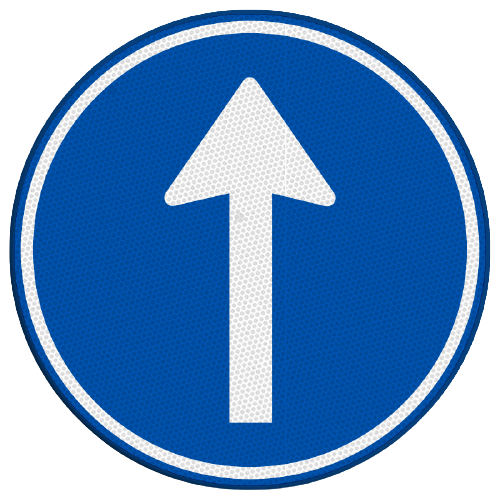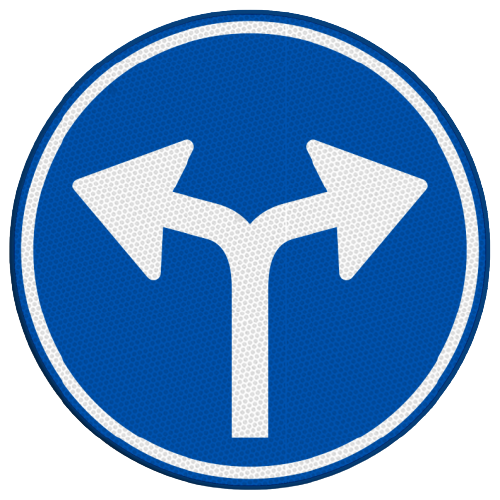Category D – Driving direction
 Sign D1 – Roundabout; mandatory driving direction.
Sign D1 – Roundabout; mandatory driving direction.
This sign is placed on the central island opposite all access roads. The sign can also be placed on access roads.
This sign is almost always used in combination with the placement of sign B6 and shark teeth at the connection of the access roads to the roadway of the roundabout.
The design of the access roads has been adapted to the priority regulations if necessary.
The above is done in such a way that drivers on the access roads must give priority to drivers on the carriageway of the roundabout.
Sign J9 is used as a preliminary indication of a roundabout.
If you do not have to give priority to (moped) cyclists when approaching a roundabout, there is always a separate (moped) cycle path.
This is usually the case outside built-up areas. But also within built-up areas, there are separate (moped) cycle paths at a mini roundabout. Sometimes cyclists and mopeds do have priority. And sometimes not! And that sometimes not can lead to the following situations. When leaving the roundabout, turn right and you must give way to all straight-going/oncoming traffic. So also pedestrians. You can then get into the strange situation that you have to give priority to pedestrians, but not to (moped) cyclists because they have been removed from priority. There are really good road managers there (NOT!!!).
The following exceptions apply on or just before a roundabout:
- Drivers of motor vehicles and moped riders following the road are permitted to drive just before or on roundabouts other than on the right side of the road.
- Drivers are allowed to overtake on the right just before or on the roundabout.
 Sign D2 – Order for all drivers to pass the sign on the side indicated by the arrow.
Sign D2 – Order for all drivers to pass the sign on the side indicated by the arrow.
This sign is placed on a traffic island or center conductor.This makes it clear on which side you should drive along the guide.
If the sign is placed on a center guide, the arrow always points to the right. In some situations, the arrow points to the left.
This occurs at road narrows.
If the sign is placed on a center conductor, this is often on a reflective yellow column.
However, the sign can also be attached to a traffic light pole or public street lighting.
If the sign is placed between the roadway and a cycle path or a bicycle/moped path, the sign is on a black/white column.
 Sign D3 – Sign may be passed on either side.
Sign D3 – Sign may be passed on either side.
This sign is placed on traffic islands or center conductors that may be driven past on both sides.
Sometimes this will not be clear at first, but because this sign has been placed it will be.
If the sign is placed on a center conductor, this is often on a reflective yellow column.
However, the sign can also be attached to a traffic light pole or public street lighting.
 Sign D4 – Order to follow the direction of travel indicated on the sign.
Sign D4 – Order to follow the direction of travel indicated on the sign.
When this sign is posted, you are not allowed to turn.
You are also not allowed to make a u-turn at this sign. Logical, because if you want to turn around you will first have to turn left and that is prohibited at this sign.
This sign is often placed at junctions with autowegen or other busy roads outside built-up areas.
Due to the higher speeds being driven, it is not permitted to turn right or left here.
Certain categories of vehicles can be excluded using bottom plates.
Do not confuse this sign with sign C3 (One-way street).
These traffic signs are often placed next to lanes where slow-moving traffic is not allowed.
There is sometimes mud on the roadway.
This was left behind by crossing agricultural vehicles.
There is sometimes a less good view due to trees.
Crossing traffic takes sufficient account of the higher speeds of other drivers.
 Sign D5 – Order to follow the direction of travel indicated on the sign.
Sign D5 – Order to follow the direction of travel indicated on the sign.
The meaning of this sign is that you MUST follow the direction indicated on the sign.Even though you can follow a different direction.It is not permitted.
You will also find this sign at connections to one-way bicycles or bicycle/moped paths on a roundabout.
To prevent driving against traffic, this sign is placed with the obligation to follow the roundabout to the right.
Using a bottom plate, this sign can apply to certain categories of vehicles or certain categories can be excluded.
The sign can be equipped with an arrow pointing to the left or right.
 Sign D6 – Order to follow one of the directions indicated on the sign.
Sign D6 – Order to follow one of the directions indicated on the sign.
The meaning of this sign can also be translated as: prohibited to turn left.You are required to either turn right or go straight.
Using a bottom plate, this sign can apply to certain categories of vehicles, or certain categories can be excluded.
The sign can also be equipped with an arrow straight ahead and an arrow to the left.
In that case, it is forbidden to turn right. You are then obliged to either turn left or go straight.
 Sign D7 – Order to follow one of the directions indicated on the sign.
Sign D7 – Order to follow one of the directions indicated on the sign.
The meaning of this sign can also be translated as: it is forbidden to drive straight ahead.You are required to either turn right or left.
Using a bottom plate, this sign can apply to certain categories of vehicles or certain categories can be excluded.
Traffic may approach from the opposite direction.
Please take this into account. Especially when you turn left.
